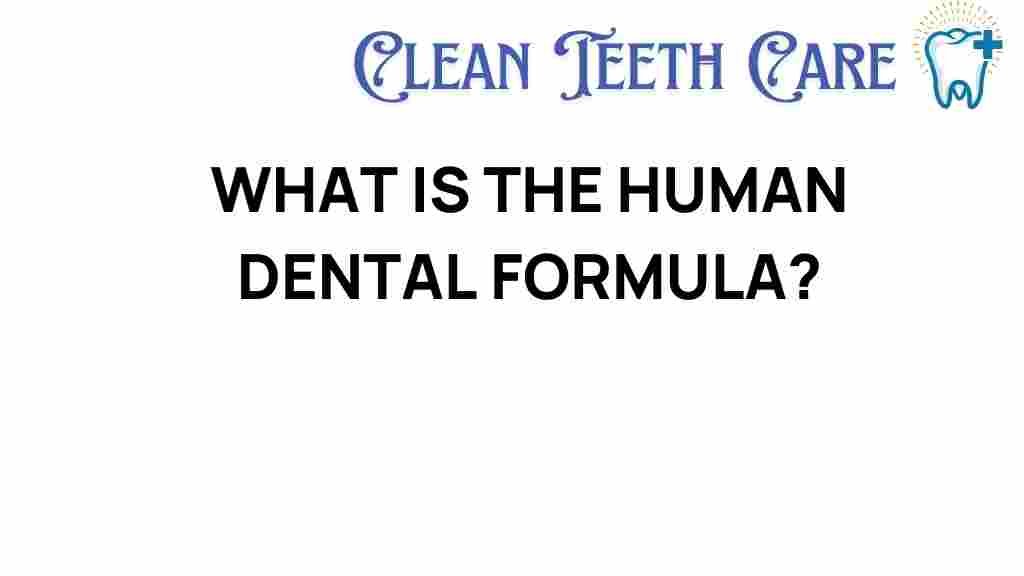Unveiling the Secrets of the Human Dental Formula
The human dental formula is a fascinating aspect of dental anatomy that plays a crucial role in understanding oral health. By exploring the structure of our teeth, we can gain insights into tooth development and the importance of proper dental care. In this article, we will delve into the intricacies of the human dental formula, providing a comprehensive guide to the anatomy of teeth and the significance of maintaining good oral hygiene.
Understanding the Human Dental Formula
The human dental formula is a representation that outlines the number and types of teeth in an individual’s mouth. Typically, adults have 32 teeth, which are categorized into four types based on their function:
- Incisors: These are the front teeth, used for cutting food.
- Canines: Located next to the incisors, canines are pointed and help in tearing food.
- Premolars: These teeth are located behind the canines and are used for crushing and grinding food.
- Molars: Found at the back of the mouth, molars are larger and are also used for grinding food.
The standard human dental formula for adults can be expressed as:
2-1-2-3 / 2-1-2-3
This notation indicates that there are 2 incisors, 1 canine, 2 premolars, and 3 molars on each side of the jaw, both in the upper and lower jaws.
The Anatomy of Teeth
To fully appreciate the human dental formula, it’s essential to understand the anatomy of teeth. Each tooth consists of several parts:
- Enamel: The hard outer layer that protects the tooth.
- Dentin: The layer beneath the enamel, providing support and structure.
- Pulp: The innermost part containing nerves and blood vessels.
- Cementum: The layer that covers the root of the tooth, helping anchor it in the jawbone.
This structure is crucial for maintaining oral health and ensures that teeth function effectively during chewing and speaking.
Tooth Development
Tooth development is a complex process that begins in the womb and continues into early adulthood. Here’s a step-by-step overview of how teeth develop:
- Primary Teeth Formation: The first set of teeth, known as baby teeth, begins to form in the fetus by around 6 weeks of gestation.
- Eruption of Primary Teeth: These teeth typically begin to erupt between 6 months and 1 year of age.
- Shedding of Primary Teeth: Children start losing their baby teeth around 6 years of age, making way for permanent teeth.
- Eruption of Permanent Teeth: Permanent teeth usually begin to erupt around age 6 and continue until the late teens.
Understanding tooth development is essential for dental education and helps parents monitor their children’s oral health.
Maintaining Good Oral Health
Maintaining good oral health is vital for preserving the integrity of the human dental formula. Here are some essential dental care tips:
- Regular Brushing: Brush your teeth at least twice a day with fluoride toothpaste.
- Flossing: Daily flossing helps remove food particles and plaque between teeth.
- Regular Check-ups: Visit your dentist at least twice a year for professional cleanings and check-ups.
- Healthy Diet: Consume a balanced diet rich in vitamins and minerals to strengthen your teeth.
Incorporating these practices into your daily routine can significantly enhance your oral health.
Common Dental Issues and Troubleshooting Tips
Despite our best efforts, dental issues can arise. Here are some common problems associated with the human dental formula and tips for troubleshooting:
- Cavities: Caused by decay, cavities can be prevented through good oral hygiene. If a cavity is present, visit your dentist for treatment options.
- Gum Disease: Symptoms include swollen or bleeding gums. Regular brushing and flossing can help prevent it.
- Tooth Sensitivity: Often caused by worn enamel. Use toothpaste designed for sensitive teeth and consult your dentist.
Addressing these issues promptly can prevent further complications and maintain the integrity of your dental anatomy.
The Importance of Dental Education
Understanding the human dental formula and the anatomy of teeth is essential for both adults and children. Dental education plays a vital role in promoting awareness about oral health. Parents should educate their children about proper dental care from a young age, establishing routines that will last a lifetime.
Schools and communities can also contribute by providing resources and programs focused on oral health. For more resources on dental education, you can visit this link.
Conclusion
In conclusion, the human dental formula is a key component of our oral health that encompasses the structure and function of our teeth. By understanding tooth development, maintaining good dental care practices, and being aware of common dental issues, we can protect our smiles and ensure long-lasting oral health.
Remember, our teeth are not just tools for eating; they play a significant role in our overall well-being. Regular dental check-ups and education about the anatomy of teeth are crucial steps in preserving our dental health. If you have any concerns about your oral health, don’t hesitate to consult a dental professional.
For more information on maintaining healthy teeth, feel free to explore this external resource.
This article is in the category Conditions and created by CleanTeethCare Team
